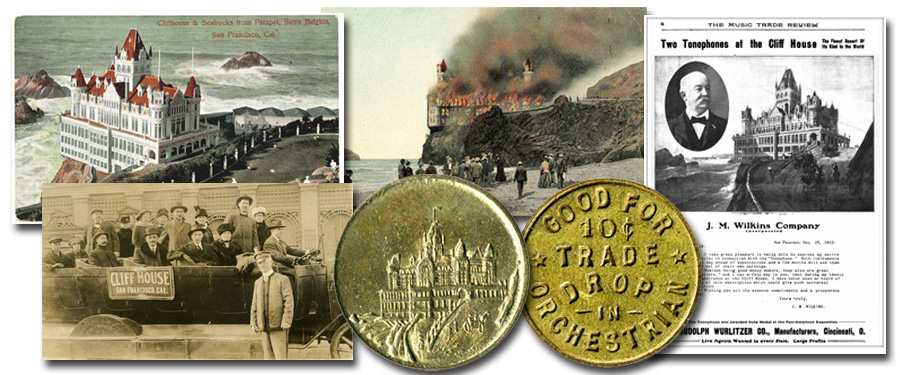
As time permits, in recent months I have been creating the second edition of A Tune for a Token, to be published by the Token and Medal Society, which issued the first edition in 1975. Some news about this was given to the CoinUpdate website then picked up by eSylum, resulting in a number of e-mails coming my way.
The focal point is a dime-size brass token depicting the Cliff House on the obverse and an inscription on the reverse, as shown here. "ORCHESTRIAN" is a misspelling of ORCHESTRION, an automatic or mechanical orchestra with a piano, ranks of pipes, drums, bells, and other instruments.
The Cliff House was the second of this name and was built by Adolph Sutro, an entrepreneur of German extraction. He made his fortune by building the famous Sutro Tunnel, the first practical way devised to drain water from deep mines in Nevada’s Comstock Lode. Following this success he moved to San Francisco where he had lived earlier and earned large sums of money speculating in real estate and business properties. He became a respected citizen and was elected mayor of San Francisco for one term. Sutro became an avid collector and amassed a tremendous collection of rare books, grew many types of exotic plants and shrubs, and gathered many artistic objects of various kinds.
Near the water he constructed the Cliff House in an elegant French Chateau style. This contained a restaurant, entertainment facilities, and more, and was a great attraction.
Information concerning the orchestrion depicted on the token is scarce. No doubt it was very large, standing 10 feet high or more, and furnished music in a ballroom, dance hall, or other facility. It must have had a slot by which a patron could deposit either a dime or one of these brass tokens.
To the right of the Cliff House was built the Sutro Baths, a vast complex of bathing pools. In various areas there were several automatic musical instruments including at least two orchestrions, these in addition to those in the nearby Cliff House. Incorporated into this structure later was the Sutro Museum which housed many of Adolph Sutro’s treasures.
The French-chateau style Cliff House burned in a spectacular blaze in 1907. Automatic musical instruments in the building were destroyed. The structure was replaced by a plain-appearing edifice which still stands today. It housed a large collection of coin-operated pianos and orchestrions gathered in the early 20th century. The Sutro Museum was closed in 1965. Its collection of instruments included many classics. Both collections were acquired by the writer in the late 1960s and distributed to various collectors and museums. Later, the Sutro Baths and Museum building was in the process of demolition when it burned to the ground in a fire of undetermined origin.
As to the brass tokens, they are not rare in the context of such pieces. Several dozen exist, typically in Very Fine to About Uncirculated grades. The market value varies, but $50 or so is a good guess.
From left to right the image features: The Cliff House; tourists being transported to or from the Cliff House; the burning of the Cliff House on September 7, 1907, an advertisement from the April 1903 Music Trade Review featuring two of the multiple automatic musical instruments that might be at the Cliff House at any given time.





